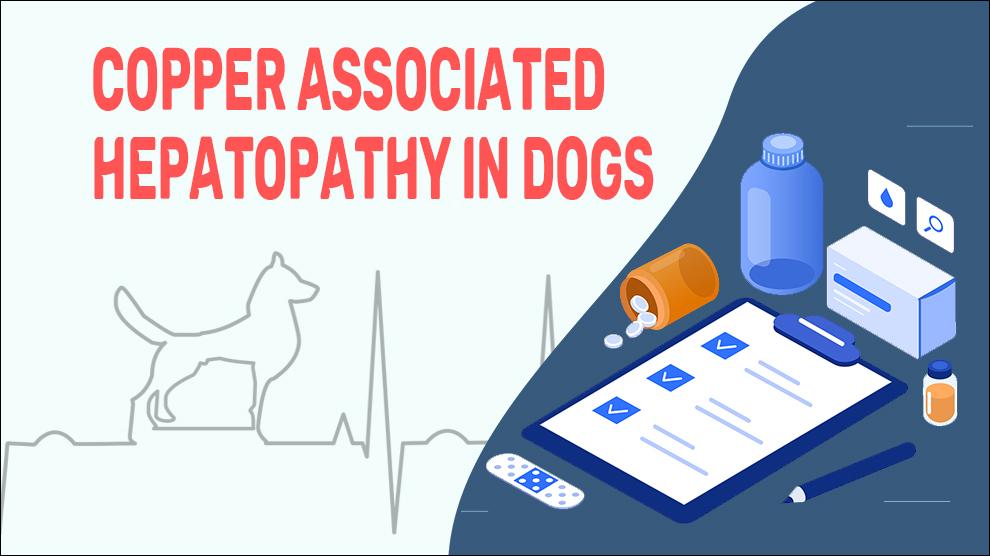Copper-associated hepatitis (CAH) is a breed-specific, inherited, autosomal recessive condition that is characterized by an abnormal accumulation of copper granules within hepatocytes, causing inflammation and oxidative damage.
Copper is an essential micronutrient and an important trace element. Sufficient amounts of copper are required for everyday cellular function as it is used as cofactors for electron transport proteins, antioxidant molecules, and numerous enzymes. Copper is rapidly absorbed from the metabolized food in the stomach by liver portal venous circulation.
Copper proceeds through one of several metabolic pathways within the liver hepatocytes. Copper accumulation in the liver is caused by increased ingestion, a mix-up in storage, or defects in the excretion of copper. The lysosomal storage capacity is overwhelmed by increased hepatocellular copper accumulations causing oxidative stress. This leads to DNA damage due to the free radical formation and lipid peroxidation. Acute and chronic inflammation eventually leads to Hepatocellular damage and cirrhosis.
Elevated alanine transaminase (ALT) activity, alkaline phosphatase (ALP), gamma-glutamyltransferase (GGT), and aspartate transaminase (AST) are the most consistent laboratory finding in dogs affected with copper associated hepatopathy.
Accumulation of hepatotoxic copper concentrations in genetically predisposed breeds manifests clinical signs within 2 to 4 years of age. Acquired copper-associated hepatopathy breeds may develop clinical signs at any age depending on the nature and severity of their hepatic dysfunction.
Symptoms Of Copper Associated Hepatopathy
- Abdominal pain
- Hepatic encephalopathy (circling, disorientation, aggression, seizures).
- Ascites (buildup of fluid in the abdomen).
- Gastrointestinal bleeding
- Vomiting
- Decreased appetite/ Weight loss
- Bloody diarrhea
- Frequent urination
- Excessive thirst
- Anemia
- Jaundice
- Ulcers
Treatment Options For Copper Associated Hepatopathy
- Therapeutic abdominocentesis - when the amount of abdominal distention is compromising the dog’s ability to breathe, the excess from the abdomen will be removed).
- Diuretics (like Spironolactone, Furosemide, torsemide, and bumetanide) promote fluid excretion.
- Antihypertensive medications - metolazone (Mykron, Zaroxolyn), Mannitol (Osmitrol).
- Antibiotic medications if the infection is suspected. Broad-spectrum antibiotics are initially started and once cultures and blood tests have been obtained, then the antibiotic choice may be changed.
- For the anorexic, nauseated, and systemically ill dogs, hospitalization for supportive therapy such as intravenous fluids might be required.
Home Remedies For Copper Associated Hepatopathy
- Adjunctively to standard therapy, Liver supplements are often used for denamarin, S adenosylmethionine (Sam E), Milk thistle, and its extracts silymarin or silybin.
- Ursodiol (Ursodeoxycholic acid): It is a naturally-occurring bile acid that improves flow through diseased bile ducts and helps reduce the viscosity of bile. (Urso, Actigall, Ursofalk).
Prevention Of Copper Associated Hepatopathy
Mutation in the COMMD1 gene has been identified in susceptible breeds, especially in a Bedlington terrier. Before buying the dogs, Owners can check with a breeder for screening.
As hereditary is the factor in some breeds, it is better to evaluate the affected dogs before breeding or at least before getting a dog from a susceptible lineage.
Affected Breeds Of Copper Associated Hepatopathy
Beagle, Bedlington Terrier, Doberman Pinscher, West Highland White Terrier, Dalmatian, Skye Terrier, Labrador Retriever
Additional Facts For Copper Associated Hepatopathy
- Causes:
Copper-associated hepatitis can occur in dogs of any age, size, or gender, but many breeds are prone to developing hepatotoxic issues with the liver.
- Types:
Primary CAH:
Similar to Wilson’s disease in humans, primary CAH is due to defective genetics and results from a defect in Copper homeostasis in the liver. Intra-hepatic copper levels seem to be higher in primary CAH than in secondary CAH.
Secondary CAH Results:
The excretion of copper or excessive intake of this compound is prevented by an obstruction of bile flow.
- Mortality:
Copper-associated hepatopathy may cause liver cirrhosis which in turn causes high fatality in dogs. Older dogs have the highest mortality rate.
- Diagnosis:
- Complete blood count (CBC), Blood chemistry profile
- CT scan and MRI
- Histopathological examination using hematoxylin-eosin staining.
- Immunohistochemical examination.
- Liver biopsy
- Prognosis:
Dogs affected by acute hepatopathy may succumb earlier before any treatment, it has a good prognosis when diagnosed early; chronic hepatopathy cannot be cured. An appropriate diagnosis of this disease is always best left to your vet to make sure that it is not progressing into a serious form.
Dogs affected with multiple organ diseases have significantly shorter survival times if left untreated. However, as chronic hepatopathy is slowly progressive, dogs can survive several years after initial diagnosis even without therapeutic interventions.
When To See A Vet
Whenever you notice below mentioned signs, contact your vet immediately:
- Abdominal pain
- Hepatic encephalopathy (circling, disorientation, aggression, seizures).
- Ascites (buildup of fluid in the abdomen).
Food Suggestions For Copper Associated Hepatopathy
- Low copper diet + Supplemental zinc
- Lean boiled meats
- Chicken baby food
- Plain steamed or baked white fish (whiting, pollock, cod, haddock, etc).
- Mashed potato (softened with fish poaching liquor).
- Skinless, minced chicken or turkey.
- Scrambled eggs
- Fiber-rich foods: Apples, Pears, Oatmeal, and other foods.
- Rice, Sweet potato, Mashed banana.
Conclusion
Generally, the diagnosis of CAP could be confusing considering the multitude of diseases implicated in the condition. Treatment of CAP is reliant on proper detection of the cause of the condition. So when you suspect something is not right, visit the vet for further clarifications.

















